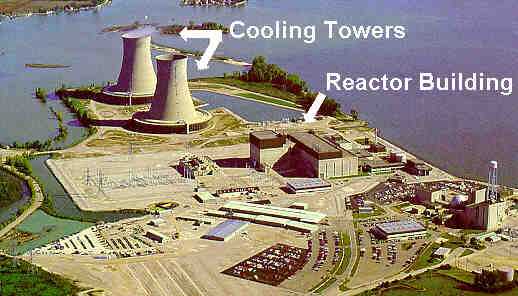The Virtual Nuclear Tourist !!! Nuclear Power Plants Around the World Nuclear Power Plants - Midwestern and Central United States |
The Virtual Nuclear Tourist !!! Nuclear Power Plants Around the World Nuclear Power Plants - Midwestern and Central United States |
The Midwestern and Central United States spans the east-west region between Ohio and Idaho and north-south between Missouri and Minnesota. States having nuclear power plants in this region are:
Michigan
Detroit Edison's Fermi-2 BWR facility is located near Monroe, Michigan on Lake Erie.
 Courtesy U of
Michigan Student ANS section
Courtesy U of
Michigan Student ANS section
The Reactor Building contains the drywell and reactor-related support equipment. The drywell contains the Boiling Water Reactor and Recirculation System pumps and piping. Support equipment includes refueling equipment, spent fuel storage, special ventilation systems, control rod drive units. Note that the Cooling Towers are of the hyperbolic design. The Turbine Building, not identified in this photo, is the long building closest to the viewer (~ 150 degrees from where the arrow is pointing). Note the substation below the cooling towers. Please refer to the U of Michigan ANS pages for more on Fermi-2.
The Fermi-1 plant, operated in the 1960's, is located in the building with the water tower on top (located in the lower right hand side of the photo).
Other facilties in Michigan include the DC Cook 2 unit PWR facility near Bridgeman, the Palisades PWR facility and the Big Rock plant site. Refer to the NRC map for exact locations.
For each of these sites, additional site-specific information may be found in the NRC Plant Information Book. I will add more information about these facilties later.
Minnesota
The Prairie Island Nuclear Power Plant is located on the Mississippi River near Red Wing, approximately 50 miles southeast of the Minneapolis-St. Paul metropolitan area. The facility has 2 units, each with a 2 Loop Westinghouse Pressurized Water Reactor. Each unit generates 560 MWe, the equivalent of half of the residential demand of the Northern States Power (NSP) service territory. In the foreground can be seen Cooling Towers. Some power plants, usually located on lakes or rivers, use cooling towers as a method of cooling the circulating water (the third non-radioactive cycle) that has been heated in the condenser. During colder months and fish non-spawning periods, the discharge from the condenser may be directed to the river. Recirculation of the water back to the inlet to the condenser occurs during certain fish sensitive times of the year (e.g. spring, summer, fall) so that only a limited amount of water from the plant condenser may be discharged to the lake or river.
Mechanical draft Cooling Towers, as in the Prairie Island case, have long piping runs that spray the water downward. Large fans pull air across the dropping water to remove the heat. As the water drops downward onto the "fill" or slats in the cooling tower, the drops break up into a finer spray. On colder days, tall plumes of condensation can be seen. On warmer days, only small condensation polumes will be seen.
The NSP homepage contains information about Monticello, dry cask spent fuel storage and the Prairie Island plant. This site contains additional information about the Prairie Island plant. For more information, please click on the link you want.
| Virtual Nuclear Tourist | Table of Contents | Welcome | FAQ | Glossary NRC | E-Mail ? |
Copyright © 1996-2004. Joseph Gonyeau. All rights reserved. Revised: August 23, 1999.